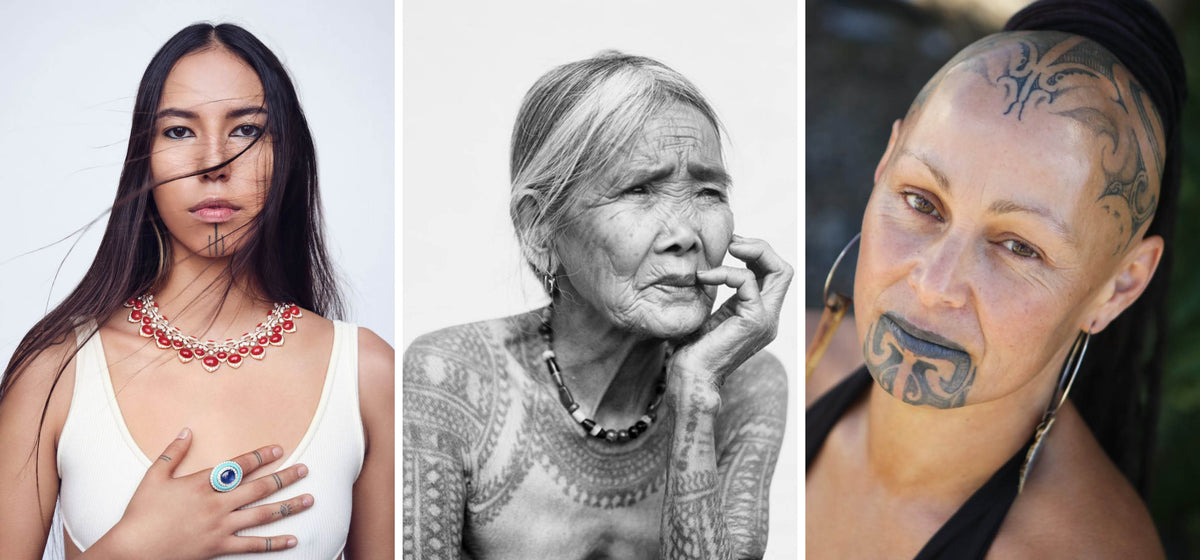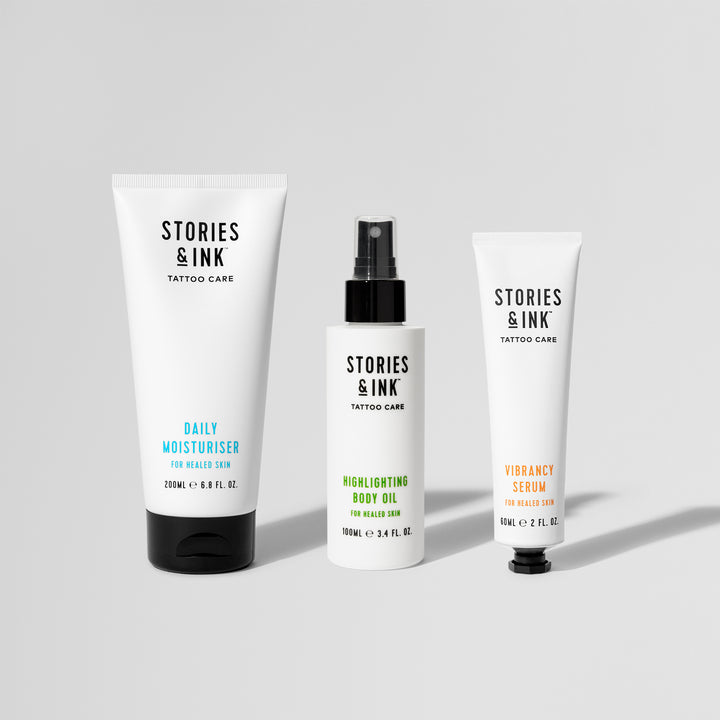The desire to alter our bodies – adorn them with tattoos, get our ears stretched and pierced – is universal, but it certainly isn’t contemporary. Marking the skin has been practiced in almost every human culture, in every part of the world, since the beginning of time.
Tattooing’s often peddled as an outsider artform, but it’s an ancient practice – one that can signify belonging to a tribe or family, to symbolise strength and female energy or simply because it’s beautiful. The indigenous populations of the world are the ones who invented tattooing. And the word itself, tattoo, comes from the Tahitian tatau, to mark or strike. The traditional form of application is where ink is tapped into the skin using sharp sticks or even bone. We believe it’s important to understand the origins of tattooing, so we set out to find the people keeping that memory – the roots of tattooing as we know it – alive…
The last Kalinga tattooist
Kalinga is a province in the north of the Philippines. Atop a mountain sits a small house, outside the house is a plywood sign, with the words: Welcome. Tattoo Artist Fang-Od written in red paint. This is the home of a woman named Whang-Od, who’s 105 years old. She’s the oldest Filipino tribal tattoo artist, and was known as the last mambabatok (or Kalinga tattooist) from the tribe of Butbut in Buscalan (although now her grandniece, Grace Palicas, is her apprentice). She was 25 when the man she was in love with died. Instead of looking for a new husband, she dedicated her life to tattooing after learning the art from her father.
For men, the Kalinga tattoo is a sign of strength, power and wealth. But they also represent beauty. For a girl, they mark a journey into womanhood – and the more tattoos you have, the more beautiful you are, according to the Kalinga. You can learn more about Whang Od and the Kalinga through the work of tattoo anthropologist, Lars Krutak.
The India Ink Archive
Tattoo artist and researcher, Shomil Shah, set up the India Ink Archive to document India’s indigenous tattoo traditions. Tattoos in India have been used as signifiers of social status, family names, and even permanent jewellery for those who couldn’t afford jewels of their own.
“I noticed that many old women you would see at the market or train stations sported tattoos similar to my great grandma's,” Shomil said in an interview for Vice. “I began stopping and asking them about it, if they were comfortable talking to me, to understand the meaning behind the tattoos and symbols on their bodies.”
Shomil wants to dispel misinformation about traditional tattooing in India by speaking to the women who wear the tattoos. Many of the tattoos were made by using a sharp thorn as a needle.
The model reclaiming traditional Yidiiltoo chin tattoo
Indigenous model Quannah Chasinghorse wears traditional facial tattoos. Her ancestry is Hän Gwich’in, from Alaska and Canada, and Oglala Lakota, from South Dakota. Growing up, Quannah saw images of her ancestors with lines marked on to their chin, the Yidįįłtoo. She decided she wanted to wear them, too. It’s tradition that the tattoo should be hand-poked by a woman. So her mother, Jody Potts-Joseph, did the markings for her when she was 14 years old, using the traditional method of stick and poke. Gwich’in tattoos are three distinctive lines on the chin, on the cheeks or corners of the eye. They are a rite of passage – usually tattooed between the ages 12 to 14 – to mark a transition into womanhood.

Quannah Chasinghorse with her mother, Jody Potts-Joseph who tattooed her. Photo by Keri Oberly
The model has since featured on iconic magazine covers: May 2021’s issue of Vogue in Mexico, the January 2022 issue of Elle, National Geographic and Allure’s beauty issue. “The model is at once redefining beauty, honouring a Native practice dating back more than 10,000 years, and challenging the notion that all models should be a blank canvas,” wrote Christian Allaire for Vogue.
“Being a part of that change and encouraging other Indigenous youth to step up and use our voices, but also to be proud of who we are, is what motivates me,” Quannah commented in an interview for Elle.

The revival of Maori moko facial tattoos
Tā moko is the art of traditional Māori tattooing. Moko kanohi are facial tattoos and moko kauae are the marks worn on the chin by Māori women. “Moko kauae is a rite of passage, a symbolic expression and manifestation of a dynamic upward movement of time and space within sacred feminine energies,” explained Piiata Lauren Turi-Heenan, from Haumoana, New Zealand, to Things&Ink. “As contemporary Maori women, we sat in an oppressive colonised state of being for well over a century. Our rites and rituals obscured, even lost to us. But Māori women refused to be imprisoned by western constraints and fought multiple states of oppression to be free from racism, sexism, prejudice.”
Piiata’s chin tattoo was inked into her skin using chisels called Uhi. Each curve of the tattoo has a meaning – the spiral, for example, represents the building blocks of life.

Piiata Lauren Turi-Heenan, photographed by Bashan Te Rau Oriwa Heenan
Other prominent figures in New Zealand also wear the traditional tattoos, including TV news anchor Oriini Kaipara. “We – Māori – are all born with our moko hidden beneath the veil that is our skin,” she says. “It is up to the individual to decide whether or not they want their moko to be revealed to the world of light. Nonetheless, it exists. It is there.”

Oriini Kaipara, photograph by Michael Bradley

